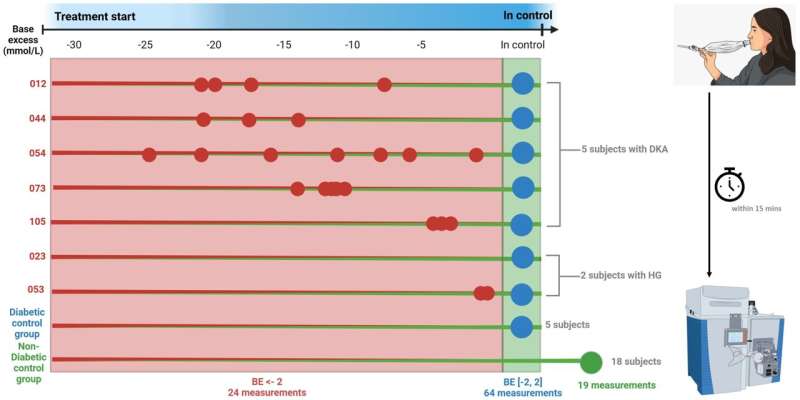This article has been reviewed according to Science X's editorial process and policies. Editors have highlighted the following attributes while ensuring the content's credibility:
fact-checked
proofread
Researchers develop new technique for breath analysis to monitor young patient health status

Researchers are using breath analysis to monitor patients' health status in real time and check levels of certain medicines. Scientists from the University of Basel and University Children's Hospital Basel (UKBB) have developed a technique that enables them to measure certain parameters from the breath exhaled by their young patients. Their results have been published in Frontiers in Endocrinology.
A comparison showed that breath sampling was as reliable a form of monitoring as conventional blood testing. Children in intensive care following diabetic ketoacidosis—a complication of diabetes that can be life-threatening if not treated urgently—were monitored during treatment.
In addition to blood and urine samples, the medical team used the air exhaled by the children to track their symptoms and monitor the effect of treatment. "The measurements from the air samples reflected the results of the blood tests perfectly," says Pablo Sinues, a professor at the University of Basel and head of a group researching respiration in translational medicine.
The principle behind their test is the same as that used to train dogs to detect certain illnesses. "The carbon dioxide we exhale also contains lots of other things that are present in our blood," the researcher explains. This means we can find traces both of medicines that have been administered and of metabolites—molecules that provide an indication of the activity in our bodies.
Results in less than 15 minutes
In recent years, Sinues and his colleagues have been developing breath tests to measure concentrations and adjust dosages of anti-epileptic treatments in children. However, since their method involved blowing directly into a laboratory analyzer, it could not be used in intensive care departments or operating rooms. But now that the team has developed special bags capable of collecting up to 1.2 liters of exhaled air, patients can simply stay in bed.
The bags, which look like ordinary plastic bags, are then taken straight to a laboratory and connected to a mass spectrometer for chemical analysis.
The spectrometer is also used to analyze blood samples. But sample processing is difficult and time-consuming, and takes many hours. By contrast, the air can be injected straight into the spectrometer from the bags and without any prior preparation, less than a quarter of an hour after being collected. Only routine blood tests can be turned around in such a short time.
This speed and the ease with which the intervals between samples can be shortened have enabled the scientists to deepen in real time their understanding of the processes taking place in the body as patients stabilize.
"Using this extremely sensitive technique, we've been able to detect a broad range of compounds. Our results go beyond what has already been described," Sinues says. "Now we have to disentangle everything." For example, differences were observed between children who had been admitted to hospital for the first time and those who attended regularly.
Other studies will be required to confirm these results, which were obtained from just five children with diabetic ketoacidosis.
Analyzing breath samples could have applications outside diabetes, since it can be used to simultaneously measure medicine concentrations and physical response. The scientists hope they will soon be able to make it part of standard care in intensive care departments.
"The fact that it is non-invasive is also very practical, especially with children," Sinues points out. "It could be used to predict treatment response or side effects." This information is particularly important when therapeutic windows are narrow, i.e., when a slightly higher dose already causes a medicine to become toxic.
"The method has proven its worth with anti-epileptics," says the researcher. "It could also be developed to measure certain cancer treatments. And the bags we're currently developing could be very helpful in managing anesthetic dose and effects during surgery."
A start-up company has been spun off from his laboratory to tackle these challenges.
More information: Mo Awchi et al, Metabolic trajectories of diabetic ketoacidosis onset described by breath analysis, Frontiers in Endocrinology (2024). DOI: 10.3389/fendo.2024.1360989



















